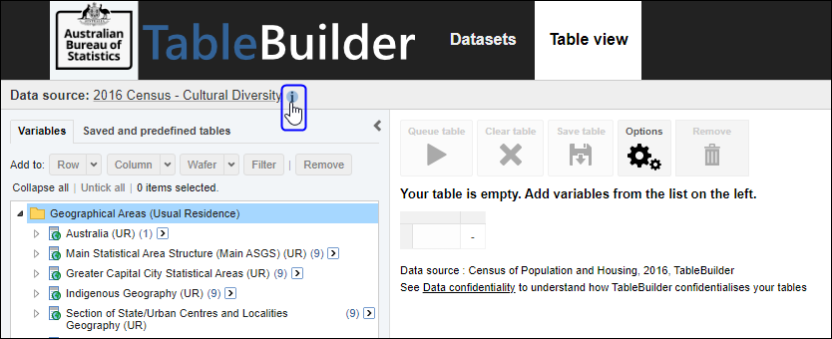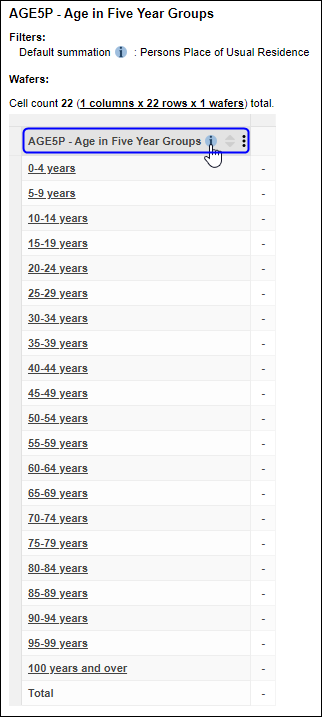Dataset help information
Access dataset information and data item lists, understand what is being counted in a table
i links
When a dataset is open, there are a number of ways to find out more information about the dataset and variables.
Information is available via the i link next to the dataset title in the Table view.
- For Census datasets, the i link opens Census Dictionary information.
- For all other datasets, the i link opens the dataset's associated microdata publication. This includes the full data item list in the Data downloads section (or in the Downloads tab in older publications).
i links open in a new tab or window so you can switch between your table and the help information.

Census variables also have variable specific information in the Census Dictionary. Click on the i link next to the variable name in the table to open the Census Dictionary description. Data quality information for Census variables can be found using the Data Quality Statements linked to corresponding entries in the Census Dictionary. These statements include information about non-response rates and any known data quality issues for each Census variable.

Census variables and geographies
- 2021 Census Dictionary
- 2021 TableBuilder variables
- 2016 TableBuilder variables
- 2011 and 2006 TableBuilder variables and geography
- Australian Statistical Geography Standard (ASGS)
- ABS Maps, an online mapping tool to view and compare ASGS regions
Confidentiality
To maintain the confidentiality of respondents and to ensure the output of quality data, some system restrictions have been implemented. These restrictions include:
- not allowing you to download individual records
- perturbing the output in your tables
- preventing the cross-tabulation of certain variables
See Confidentiality and How the data is processed.
You need to agree to Conditions of use when using TableBuilder. The ABS may impose a limit on the maximum number of tables per user.
Understanding what is being counted in a table
The type of record you are counting is displayed at the top of the table.
Census datasets provide information about persons, families and dwellings. Select the appropriate dataset based on what you want to count.
Examples of records that may be counted in Census or other TableBuilder datasets include:
- households
- families
- people
- motor vehicles
- businesses

Census of Population and Housing datasets
Place of usual residence - counting persons and families
This is the place where a person usually lives. It may or may not be the place where the person was counted on Census Night. Usual residence data is less likely to be influenced by seasonal factors such as school holidays and snow seasons, and provide information about the usual residents of an area. It is often used by government agencies when allocating funds to regions.
Place of enumeration (location on Census night) - counting persons, families and dwellings
Census place of enumeration is a count of every person in Australia on Census Night, based on where they were located on that night. This may or may not be the place at which they usually live. It includes people who are on long-distance trains, buses or aircraft, or on board vessels in or between Australian ports. It includes overseas visitors.
This type of count provides a snapshot of an area on Census night. Although the Census is timed to attempt to capture the typical situation, holiday resort areas such as the Gold Coast and snow fields may show a large enumeration count compared with the usual residence count.
Persons, 15 years and over
The Census also provides information about the working population. This consists of persons aged 15 years and over who were employed in the week prior to Census night. The data collected relate to all workers, regardless of the hours worked. The Journey to Work data on which this is based are used by transport authorities, associated bodies, organisations and other interested people to plan public transport systems, and for the development and release of residential and commercial land.